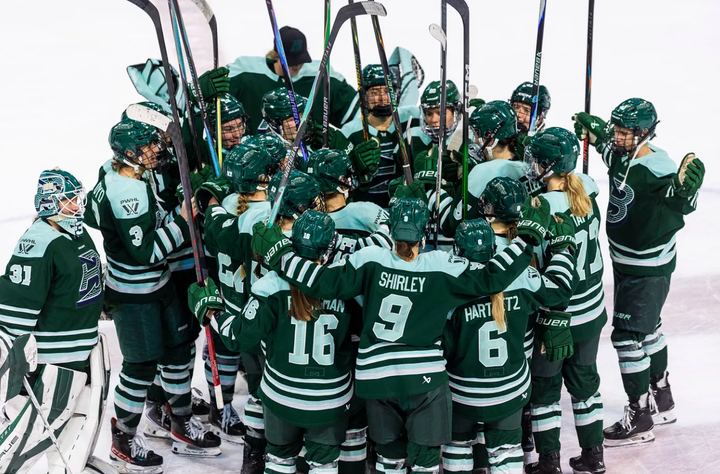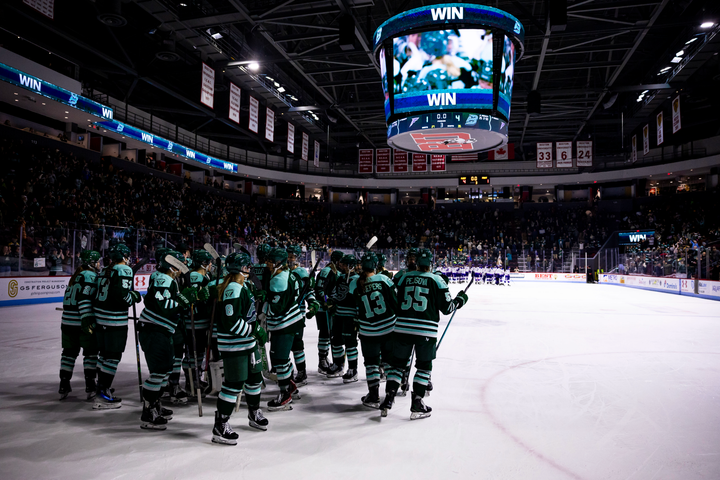Wicked Angles: Longtime salary silence in FA shows how far PHF has yet to go transparency-wise
When the PHF first announced its salary cap and player benefits being expanded for Years 8-10, it certainly felt like the start of a new era for professional women’s hockey. A doubled salary cap, in particular, meant, at least on paper, more opportunities to find out what players are making and in turn determine what players are worth, at least out of the gate. It certainly wasn’t going to be groundbreaking — after all, the entire salary cap for a PHF team is barely more than the base salary for a men’s professional hockey player. But it was a step in the direction we all wanted to see the Fed and any other pro women’s league venture into.
However, the Fed and its teams have had other ideas, as per usual.
For reasons we still can’t decipher, the Federation’s position (as told to The Victory Press back in January) has been that players’ salaries are not to be disclosed. Our own Mike Murphy tried to change this with his spreadsheet covering free agency from May 1 onward, and from the onset it seemed like multiple players were willing to come forward and disclose the numbers. Some, like Cassidy MacPherson, were making less than the median salary for the area in which they live, but my guess is that these players know for better or for worse the importance of being transparent about their income while playing in this league.
But as free agency drags on, the information surrounding these numbers has seemed to dry up. Moreover, there are NDAs and other clauses in players’ contracts that have forbidden them to go public with their salaries — a curious development in the wake of all the pomp and circumstance the PHF utilized when it announced its salary cap doubling. Entire teams, like the Boston Pride, have also elected to stick with their usual method of announcing all signings once the entire roster has been finalized, which makes it even harder for us to know what players are making and what they’re able to negotiate for.
This is coming ever closer to changing with the recent change in regime. New PHF commissioner Reagan Carey stated as much during the Fed’s recent press conference to NBC’s Alex Azzi:
"I don't see a scenario where our league will go after any players (for disclosing their salaries). That sounds pretty aggressive and not the kind of relationship we want with players." -PHF Commissioner Reagan Carey
— Mike Murphy (@DigDeepBSB) July 12, 2022
(Question from @AlexAzziNBC in today's press conference)
With that said, the fact that this even has to be a question (especially in the wake of so many actions depicting the contrary) is in itself a huge confusion. Why does this even need addressing, and why are we only now hearing of it possibly changing — especially when it’s been a thing in the past?
The controversy surrounding salary disclosure in any workplace is nothing new. Each state has its own rules regarding whether employers can or can’t ask what their prospective employees are making or have made in the past, which makes it a lot dicier than it normally would. Some players are concerned their day jobs may be affected, an unintended side effect of salary disclosure that continues to illustrate why capitalism is the worst. No player who has to rely on two incomes should have to worry about their everyday employer suddenly choosing to lower their salary just because they’re making money elsewhere. Pay employees their due for the work they’re doing — especially women, since if it weren’t for the structures in place that have limited their opportunities for so damn long, they would not be in this situation in the first damn place.
Obviously, professional sports is its own monster, but even when considering that, I guarantee most of us can’t remember a time when athletes’ salaries weren’t disclosed to the public. With a splashy deal comes splashy numbers, whether in MLB, NBA, NFL, or NHL dealings. There are entire sites dedicated to these deals, such as CapFriendly, and ongoing discussion about what players should or should not be earning based on their performance proliferates in social media — for better or for worse, as debates can spark regarding whether someone is worth their contract or not.
Men’s hockey, for its part, has entered its fourth decade of league-wide salary disclosure, and in turn the earnings for players have skyrocketed since 1990. In the face of what was then massive opposition, it became mandatory for teams to show each other the money and that, in turn, has been much more of a positive than a negative for the athlete.
It stands to reason, then, that if any pro women’s hockey league wants to achieve status as such, it will need to at least offer its players the option of being upfront about what they’re making. And this includes any league the PWHPA has a hand in, as it’s been similarly shady with regard to where their sponsorship money is going and how much players are actually taking in to participate in their movement. You can’t crow publicly about how much more money you’re pouring into the product and then bar players from talking about how much they are benefitting from it, especially since no one here is under some delusion that the money is just flowing like water.
Salary transparency allows players to see where they stand with regard to how much they can make in a given season, based on their performance and where they are in comparison to other players. A Carly Jackson-type can negotiate for more when she knows what someone like Amanda Leveille is making, or Katie Burt. Someone like Kristen Barbara can give a better idea of what, say, Emilie Harley can earn. Instead, there’s this sort of haziness about the numbers almost like smog on a summer day, making it difficult to really tell what’s going on from a distance — and that does the players a huge disservice.
Fans also like to discuss the “nerdier” aspects of sports business, including where each team stands cap-wise and what they’ll need to do to secure X player for Y number of years. This keeps them engaged, keeps them following along, and keeps them rooting for players and teams because they want to see those numbers at work.
On principle, it just doesn’t make sense either. You can’t crow from the rooftops about how much more you’re going to be giving your players and then shut them down when they start talking about the specifics. There’s no real argument for it, especially when we as fans and media know the salaries are going to be small to start, relatively speaking. All it seems to do is create even more of a question about how much this Fed really cares about its players, and how much it just wants the optics of caring.
This also highlights the need for an actual players’ union and better player representation throughout free agency. Obviously, with this being the first free agent period of its time, this is a trial and error process. Things aren’t going to go smoothly for either front offices or the players. However, with a players’ union in place, better and more varied opportunities for representation and negotiation would follow.
But hey, don’t take my word for it. Take the fans’ (and likely some players as well — I know y’all follow us!). Eighty-six percent of women’s hockey fans think salary disclosure should be an option as per our recent TIG Reacts poll, and my own personal poll via Twitter had that percentage even higher at around 96 percent. This is clearly something people want, and something universally (more or less) agreed upon as a good thing for the players in the end.
So again, I ask the PHF... why did it take this long? And what’s it going to take to keep this from ever happening again?





Comments ()